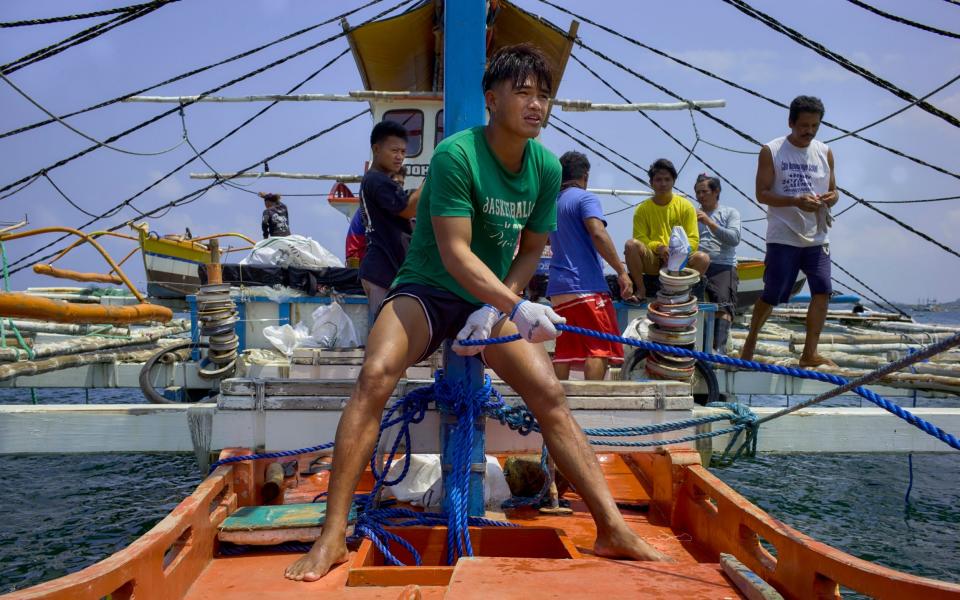How China's 'maritime militia' seized the Philippines' prime fishing waters

- Oops!Something went wrong.Please try again later.
It was broad daylight when the Chinese coastguard brazenly boarded the long wood-panelled Filipino fishing boat and made their demand.
Brandishing guns, they inspected the crew’s haul and selected the biggest and best fish to take with them. In return, they offered some packets of expired instant noodles.
“They began to bully them, choosing the precious fish and leaving all the small ones,” said Leonardo Cuaresma, 57, head of a fishermen’s association in the busy seaside village of North Pablacion in Zambales province. “The crew were afraid to react when they saw the firearms.”
The incident occurred a few years ago, and the Philippine government lodged a complaint. The Chinese foreign ministry said it was investigating the reports and would “seriously” deal with them if true.
But this sort of intimidation is far from an isolated incident. As the fishing community’s leader, Mr Cuaresma has documented a long campaign of Chinese harassment that has forced Philippine boats out of the contested nearby Scarborough Shoal lagoon, from aggressive warnings shouted over megaphones and chains of buoys roping off areas, to the use of water cannons and even boats being rammed.
The tactics are a key part of Beijing’s increasingly aggressive approach to staking its claim to various waters across the strategic and valuable South China Sea.

Although the process has been under way for years, with China quietly building military installations, runways and other buildings on disputed parcels of land, Indo-Pacific countries such as the Philippines are now increasingly fighting back..
Under President Ferdinand Marcos Jr, who came to power last year, the government has significantly hardened its stance, telling Beijing to stop its “coercion and intimidation” and signing a deal with Washington to allow US troops more access to Philippine military bases.
The exact location of the bases is expected to be revealed soon but last week Mr Marcos indicated it would include areas facing the flashpoints of Taiwan and the South China Sea.
Bases in the north overlooking the Luzon Strait in particular would give the US a staging ground close to waterways that would be “extremely critical,” in a conflict, said Dr Collin Koh of Singapore's S Rajaratnam School of International Studies.
“For any US forces coming from Guam or Hawaii, these waterways are likely going to provide direct access into the theatre,” he said, adding that China’s navy counted on the same passageways to break out into the Pacific.
The Philippine coastguard has also intensified its surveillance and patrols. Last month, Admiral Artemio Abu, the country’s coastguard chief, said his force would deploy additional vessels and conduct more sorties to better protect the Philippines’ territorial waters and fishing activities.
“We’re making sure that the presence of coastguard vessels is felt by fishermen in the area,” he said.

In recent weeks, his agency has increasingly and publicly called out China’s behaviour, even filming and releasing footage of incursions.
In February, for example, it accused a Chinese coastguard ship of hitting and temporarily blinding a Filipino crew with a military-grade laser, calling it a “blatant” violation of Manila’s sovereign rights.
It’s a familiar story to the fishermen of Zambales – who fear the official fightback may have come too late to save their shattered livelihoods.
In small coastal villages where the houses are made of concrete and wood, the ports are losing the hum of once vibrant commerce – the violent tactics of Chinese boats have made earning a living almost impossible.
In years gone by, they would sail out to the Scarborough Shoal - a 58-square-mile triangular chain of coral reefs and rocks that lies 119 nautical miles east of Zambales, and a bountiful source of large reef fish such as tuna and blue merlin.
It is known locally as the Panatag Shoal and was administered by the Philippines until the Chinese muscled them out during a bitter standoff in 2012.
The friction has continued despite a 2016 ruling by the arbitration court in The Hague that invalidated Beijing’s sweeping claims over the South China Sea and recognised Manila’s sovereign rights in its 200-nautical mile exclusive zone, which includes the Scarborough Shoal.
But China - which views the disputed waters as key to its strategic and military ambitions, including a possible invasion of Taiwan - has ignored the court’s verdict.
These days, anyone who dares go to the shoal is almost instantly harassed, said Mr Cuaresma.
“When the Chinese coastguard see Filipino fishermen, they shoo them away with megaphones,” he said.
“It’s had a big impact on fishermen’s livelihoods, their businesses, their families, even food, which is now more expensive. It’s like a domino effect.”
Pamalakaya, a national federation fighting for fishermen’s rights, says Zambales fishermen are losing some 70 per cent of their income due to Chinese territorial aggression. Damage to the shoal’s coral reefs by Chinese clam harvesters has further destroyed breeding grounds and led to dwindling stocks, fishermen claim.
Miguel Betana, 55, a fisherman of almost 30 years, has been playing hide-and-seek with the Chinese coastguard and fishing fleet ever since his boat was water-cannoned from a range of 20 metres back in 2013.
“We hid inside the boat and the water was striking the window,” he said.
Filipino fishermen were now too afraid of confrontation with China’s so-called “maritime militia” to venture too far from shore, even within Philippine waters, he said.
“Now we have to go it alone. I used to earn 10,000 pesos (£149) a week but now I’m lucky to get 5,000.”
Mr Betana said he felt hopeless. “My colleagues have changed jobs to become carpenters and drivers. For now, I’m still fishing. I have four children but would never encourage them to take up fishing,” he said. “I don’t want them to experience what I have.”

